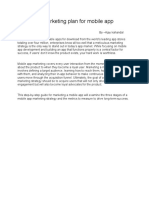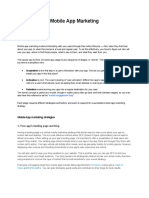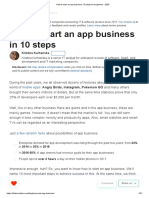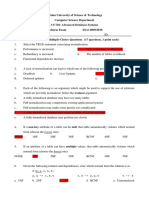0% found this document useful (0 votes)
67 views4 pagesReto de Lectura 1: Durante El Reto, Puedes Recurrir A Los Diccionarios y Glosarios Igual Que A Tu Material de Clase
The document discusses four common reasons why apps fail: 1) Not solving an actual problem for users. Apps must address real problems or needs that users have. 2) Only targeting a domestic audience without considering global potential. Emerging markets like Africa and the Middle East represent opportunities for growth. 3) Failing to properly market the app. Marketing and advertising are needed before and after launch to generate awareness and downloads. 4) Not having a monetization strategy. Apps need a way to generate revenue, such as freemium models, in-app purchases, or other options to sustain ongoing development.
Uploaded by
Antonella GarciaCopyright
© © All Rights Reserved
We take content rights seriously. If you suspect this is your content, claim it here.
Available Formats
Download as PDF, TXT or read online on Scribd
0% found this document useful (0 votes)
67 views4 pagesReto de Lectura 1: Durante El Reto, Puedes Recurrir A Los Diccionarios y Glosarios Igual Que A Tu Material de Clase
The document discusses four common reasons why apps fail: 1) Not solving an actual problem for users. Apps must address real problems or needs that users have. 2) Only targeting a domestic audience without considering global potential. Emerging markets like Africa and the Middle East represent opportunities for growth. 3) Failing to properly market the app. Marketing and advertising are needed before and after launch to generate awareness and downloads. 4) Not having a monetization strategy. Apps need a way to generate revenue, such as freemium models, in-app purchases, or other options to sustain ongoing development.
Uploaded by
Antonella GarciaCopyright
© © All Rights Reserved
We take content rights seriously. If you suspect this is your content, claim it here.
Available Formats
Download as PDF, TXT or read online on Scribd
/ 4




















































































